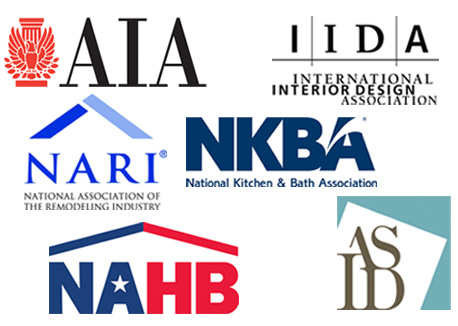It’s really counterintuitive when you think about it, but almost no one
asks a swimming pool builder if he belongs to a professional
organization, although there is one, the Association of Pool & Spa
Professionals. A poorly installed pool is a nightmare of epic
proportions, but it seems like people will often let any guy with a
truck and tools put one in.
On the other hand, association
memberships have become pretty much mandatory for professionals in the
design industry, including those who design kitchens and baths. Walk
into someone’s house to bid on a kitchen, bath
or full redesign and the first thing you’ll hear is: “What are your
credentials?” If you can’t show a certification from a credible design
organization, you’re not likely to even get in the door.
Credibility
is one of the key core benefits of association membership. That and
access to insurance and continuing education are the main reasons many
people belong. However, if you’re just taking the occasional CEU course
to keep your certification current or showing up at the Christmas party
to catch up with old friends, you’re not making the most of what an
association has to offer. You’re also not really contributing, other
than your dues. Getting involved in association committees and
activities not only helps the organization, it can add to your business
success.
GET INVOLVED
You’re probably aware
that there are several associations that cover the design community in
the United States. Some of the most popular include the American Society of Interior Designers (ASID), the National Kitchen & Bath Association (NKBA), the International Interior Design Association (IIDA) and the International Furnishings and Design Association (IFDA).
All are well-respected and offer the core benefits of credibility,
insurance and education. Some designers belong to one, two, three or
all four.
Belonging to more than one association is not a bad
idea. You can receive the different newsletters from each organization,
giving you broader access to a variety of industry news. The education
programs typically differ so you can have more professional development
options from which to choose. Ancillary benefits such as access to
business tools and legislative efforts can vary from group to group,
and the list goes on.
However, given the demands of your own
business, you realistically only have time to be actively involved in
one association. Make sure that you choose one that:
• Is most closely aligned with your business
• Offers the most opportunity for meaningful engagement
o impact on program development
o leadership potential
o increased visibility
• Has the most potential to help you increase your business
BUILD YOUR PROFILE
One
of the most effective ways to both raise your profile and enhance your
reputation is through developing and delivering CEU courses. Conceiving
a useful educational program and presenting it to the membership is an
excellent resume builder and business development tool. Demonstrating
that you are teaching other design professionals positions you as a
leader and adds a layer of credibility when pitching prospects.
Another
great tactic that will benefit you and the other association members is
to develop programs that interface with potential customers. Holding
design events for consumers in settings such as show homes or design
showrooms can increase visibility and add to the bottom line of you and
your fellow designers.
Becoming part of association leadership
is also an excellent reputation-booster. Many organizations rotate
officers yearly. Often starting in positions like secretary-treasurer
is a direct stepping stone to becoming president.
Being involved
in leadership and developing CEU programs can also give you entrée to
other associations that might be able to send you business. What if you
developed an interior design course that had relevancy for architects
and enabled them to gain required CEU credits? You could get sanctioned
by the American Institute of Architects (AIA)
to deliver the program to the local chapter in your area. It’s not
unusual for architects to give referrals to preferred designers.
Or how about developing a course for members of the World Floor Covering Association (WFCA) on design considerations when recommending flooring to consumers? Another potential connection is the Wallcoverings Association (WA).
These are probably all organizations that are familiar to you. The key
is to start looking at these and other associations with an eye toward
how you can both supply and derive a benefit.
NETWORK EFFECTIVELY
It’s
no secret that networking is critical to gaining new business. But
networking isn’t just about how many direct contacts you can make.
Effective networking can also take the form of reaching a group of
people at once, each of whom has their own network and so on.
This
may seem obvious, but it’s worth reinforcing: It’s easier to meet 10
people who know 1,000 people than it is to meet a 1,000 people
yourself. That is one of the greatest benefits of association
membership: the ability to create a large network of potential
referrals. But you have to put something in to get something out. So go
out there and get involved.
Dick Wolfe is VP of Gibbs & Soell Inc.,
a leading independent public relations agency that specializes in the
residential and commercial building and remodeling industries. As
leader of G&S’ Consumer Lifestyle and Building Solutions Practice,
Wolfe brings deep experience as a trusted communications adviser to
companies seeking successful brand positioning, marketing
communications and visibility campaigns that focus on the design
community. To contact Wolfe with questions and suggestions on topics
for future articles, please email him at [email protected].









